Industrial Application Reports | What difficulties does blockchain have in medical and health applications? Attach 10 specific case studies
Editor's Note: The original title was "Blockchain opens a new chapter in medical health-Huobi Blockchain Industry Application Report Series 2"
Summary
The healthcare industry is one of the largest and fastest-growing industries in China. With the increasing demand for residents' retirement and health management, China's medical and health industry has developed rapidly. The scale of China's large health market is expected to increase to 17 trillion yuan in 2022. This report focuses on the analysis of three major sectors in the medical and health industry: medical services, pharmaceutical manufacturing and medical health insurance. Due to the particularity of the medical field, poor data circulation and information asymmetry have created many problems such as poor medical experience, doctor-patient contradictions, counterfeit medicines and poor medicines.
In the face of various problems or pain points in the medical and health industry, blockchain technology, with its distributed, immutable, and traceable features, can open the flow of medical data and improve the mutual behavior of institutions on the premise of ensuring the privacy of patient data. The status of data silos, rebuilding trust between doctors and patients, and improving industry efficiency. By virtue of its inherent characteristics, the blockchain can make a significant contribution to the medical and health industry in many aspects such as data sharing and circulation, establishing a trust mechanism, and tracing the source of circulation.
- Opinion | The first year of the central bank's digital currency, and the sovereign and non-sovereign endorsed digital currency game framework is not yet complete
- Enterprise Ethereum Alliance (EEA) officially releases test network, blockchain era of interoperability is approaching
- Using data to review 2019 of decentralized exchanges
However, blockchain technology is not a panacea. In addition to the intricate industrial links of the medical and health industry, it also involves issues such as administrative supervision. The industry has certain specialities. The application of blockchain technology to the industry will face certain challenges. The difficulties mainly include: (1) medical data standards have not been unified, and information collection and circulation will be blocked; (2) the system between medical consortia is difficult to connect, and data silos still exist.
The emergence of blockchain technology is expected to promote the development of the medical and health industry. In the future, the combination of blockchain and AI big data, the use of real-world, high-quality data precipitated by the blockchain for algorithm optimization and deep learning will promote the development of medical science; in addition, regulatory agencies and industry associations may become the construction of major medical alliance Pushing hands.
The application of blockchain in medical health mainly involves aspects such as patient ID authentication, electronic cases, clinical research and development, drug traceability, and medical insurance claims. Because blockchain technology is still in its early stages of development, it is difficult to process medical data with complex dimensions and the particularity of the medical industry. So far, blockchain technology has not been widely used in the medical industry. In the end, this article sorts out some existing application cases worldwide and makes a brief analysis of them.
I. Overview of the development of the medical and health industry
The medical and health industry aims to protect the physical and mental health of the people. It mainly includes medical services, health management, medical insurance, and other related services. It involves a wide range of industries and long industrial chains, including pharmaceutical preparations, medical devices, health supplies, health foods, and Fitness supplies and more. With the increasing demand for residents' old-age care and health management, it not only promotes the sustainable development of the medical field and achieves major breakthroughs, but also promotes the acceleration of business model innovation and industrial integration. In the future, people's spending on pensions and medical services will increase. The medical and health industry is one of the largest and fastest-growing industries in China.
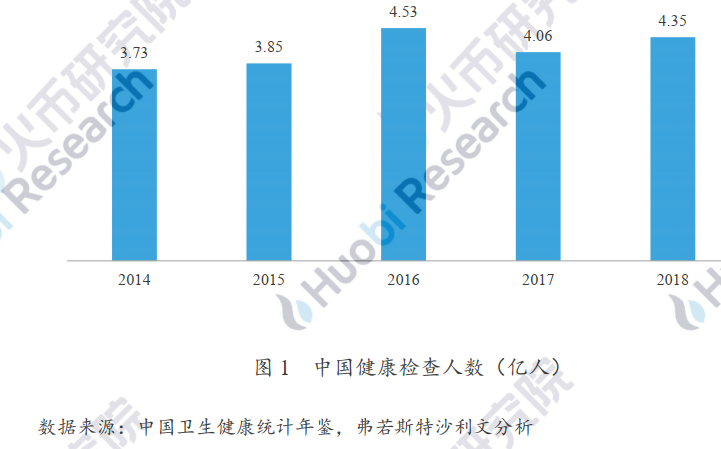
According to Frost & Sullivan data, China's total health expenditure in 2018 reached 5.8 trillion yuan, accounting for 6.4% of total GDP, and the compound annual growth rate of health expenditure in 2015-2018 reached 13.0%. Among developed countries, the total US health expenditure accounted for 17.1% of GDP in 2016, while Japan's total health expenditure accounted for 10.9% of total GDP during the same period. It can be seen that China's expenditure on health expenditure is somewhat different from that of developed countries.
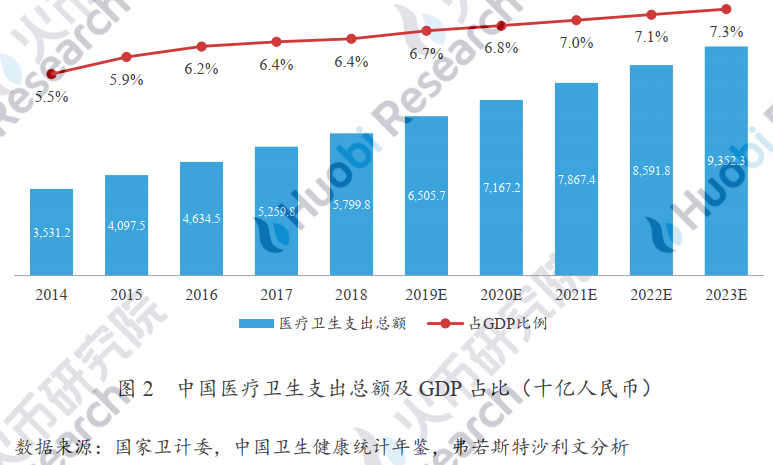

According to Frost & Sullivan data, the scale of China's large health industry in 2018 reached 11 trillion yuan, 1.8 times that of 6 trillion yuan in 2013, and the compound growth rate in 2013-2018 reached 12.7%. Frost & Sullivan predicts that the total size of China's large health market will reach more than 12 trillion yuan in 2019, and it will grow to 17 trillion yuan in 2022, which has huge room for industry development.

1.1 Development Status of Medical and Health Industry
Looking at the entire medical and health industry, it is essentially composed of many large vertical segments, including medical services, medical devices, medical informatization, pharmaceutical manufacturing, and insurance. There are many links in each vertical segment. , And the relationship between each other is complex.
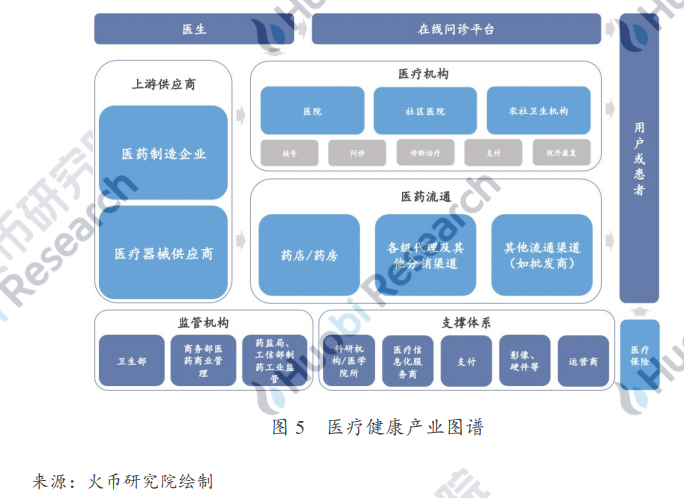
This article will mainly elaborate from the medical service, medical manufacturing and insurance and other medical and health industry links that are close to people's livelihood.
1.1.1 Medical Services
According to Frost & Sullivan's data, the market size of China's public and private hospitals in 2018 was close to 3.2 trillion yuan, and it is conservatively estimated that the market size will reach 4.9 trillion by 2023, and the hospital market will continue to expand.

From the number of hospitals, from 2014 to 2018, the number of public hospitals in the country continued to decrease, and the number of private hospitals continued to increase. By the end of 2018, the number of private hospitals exceeded 20,000, while the number of public hospitals was 12,000. This is partly a direct response of private capital entering the hospital market.

At present, there is still a big gap between private hospitals and public hospitals in terms of the number of patients and technical strength, but this gap is gradually narrowing. Private hospitals have already played a pivotal role in the domestic medical market. Coupled with policy liberalization and support, private hospitals will play a more important role in China's medical industry.
With the development of Internet technology, medical services have gradually "touched the Internet." Most of the "Internet + Medical" solutions have transformed the traditional medical infrastructure and medical consultation process through informatization and digitalization, accelerating the transfer of medical resources across institutions and regions, and improving the efficiency of the industry.
According to Frost & Sullivan's forecast, the size of China's Internet medical market will reach 26.7 billion yuan in 2019 and increase to 197.8 billion yuan in 2026, showing a steady growth trend.
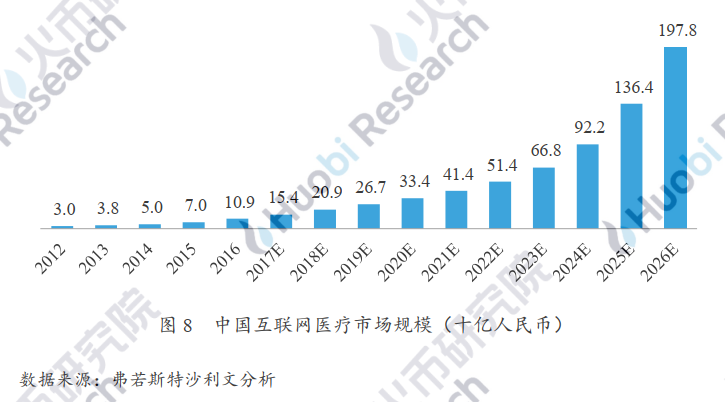
Internet healthcare cannot replace offline physical hospitals, but it can help revitalize the existing "stock" resources of medical care, optimize the allocation of high-quality medical resources, popularize a wider audience, and improve the richness of existing resources of primary medical institutions. Good service to the people.
1.1.2 Pharmaceutical manufacturing
China is the world's second largest pharmaceutical market after the United States. According to Frost & Sullivan's data, the size of the Chinese pharmaceutical market has increased from 1.1 trillion yuan in 2014 to 1.5 trillion yuan in 2018, with a compound annual growth rate of 8% and is expected to gradually increase to 3.2 trillion in 2030 RMB. The growth was mainly driven by the aging population and the corresponding increase in the prevalence of chronic diseases and the preferential policies of the Chinese government, which aims to develop the high-quality innovative drugs and biologics market in China, increase disposable income and expand coverage.
China's pharmaceutical market can be divided into chemical drugs, traditional Chinese medicine and biological drugs according to the types of drugs. Among them, biological agents are the fastest growing types of drugs, with a compound annual growth rate of 22.4% from 2014 to 2018, which is much higher than the growth of the entire industry. Level.
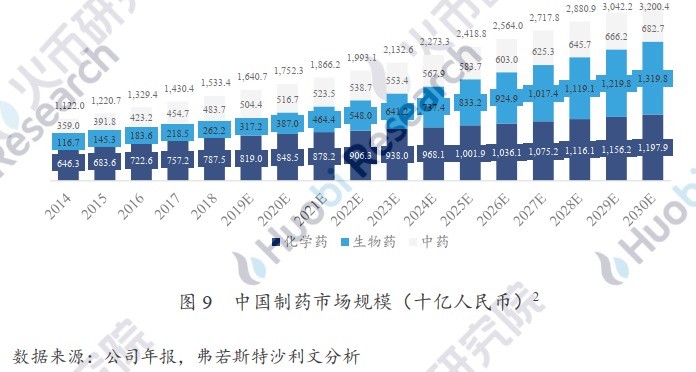
In the pharmaceutical industry chain, because some pharmaceutical companies do not have sufficient resources or energy to focus on all R & D and production of drugs, they tend to outsource this part of work to institutions with professional qualifications. These institutions are called contract R & D service providers. (CRO) and contract manufacturing service providers (CMO). Driven by the increasing pharmaceutical R & D expenditure of pharmaceutical companies and the increasing demand for pharmaceuticals, the outsourcing contract service market for pharmaceutical R & D and manufacturing has shown a rapid growth trend.
According to Frost & Sullivan's data, the size of China's contract research and development service market increased from US $ 2.1 billion in 2014 to US $ 5.9 billion in 2018, with a compound annual growth rate of 29.2% and is expected to grow rapidly to US $ 21.4 billion in 2023 , A compound annual growth rate of 29.6%.

The size of China's contract production service market increased from 1.2 billion US dollars in 2014 to 2.4 billion US dollars in 2018, with a compound annual growth rate of 19.8%, and is expected to reach 8.5 billion US dollars by 2023.

1.1.3 Medical health insurance
Medical insurance generally refers to basic medical insurance, which is a social insurance system established to compensate workers for economic losses caused by disease risks. The medical insurance fund is established by the employer and the individual to pay fees. After the medical expenses incurred by the insured person for medical treatment, the medical insurance institution will give them certain financial compensation.
By the end of 2018, a total of 1.345 billion people had been included in urban basic medical insurance in China, which basically covered all nationals, and the gap with major developed countries had narrowed significantly.
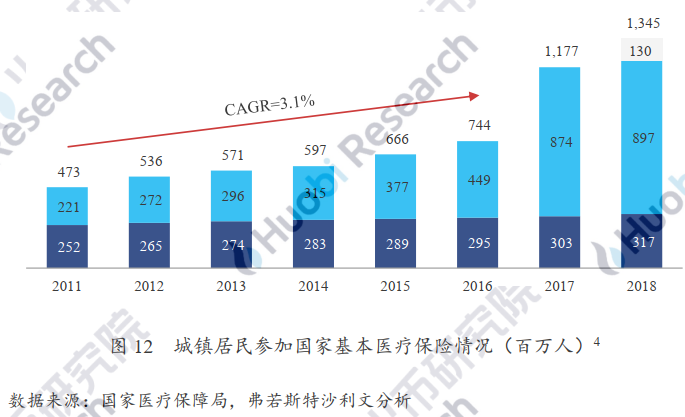
Although China's current medical insurance system has been basically established, insufficient medical insurance protection has always been a prominent contradiction in China's medical insurance system, and residents generally have a heavier burden. This is specifically reflected in the low level of protection provided by China's medical insurance, and the conditions for enjoying benefits are relatively harsh.
Commercial health insurance is an effective means to supplement basic social medical insurance, and it is the main direction of China's development of the medical and health industry. Health insurance can supplement the medical insurance gap and enhance the protection. China's commercial health insurance has developed rapidly with the development of social medical insurance. The two depend on each other and develop together.
The medical expenses of residents in China are rising rapidly, but the proportion of personal expenditure is still relatively high, and the medical burden on residents is relatively heavy. Comparing the structure of medical expenses in various countries, it can be found that in 2014, China's personal health expenditure accounted for 32.0%, the highest proportion in countries implementing social medical insurance and national medical insurance, indicating that Chinese residents still bear a huge medical expenditure burden.
By 2018, China's total health expenditure is about 5.9 trillion yuan, an increase of 12.4% year-on-year. Although the proportion of personal health expenditure has dropped to 28.6%, it is still relatively high compared with major developed countries. China ’s health insurance still has a lot of room for growth in the future adjustment of the overall health expenditure payment structure. Coupled with the continuous increase in residents ’health awareness and the continuous increase in disposable income, the willingness to purchase health insurance to reduce the burden of medical costs has continued to increase. Insurance will inevitably benefit from this and develop rapidly, occupy a more important position in the overall health payment structure, and become a powerful supplement to basic social medical insurance.

At present, China's commercial insurance is developing rapidly. The commercial insurance fund realized premium income of 544.8 billion yuan in 2018, and the health insurance premium income grew at a compound annual growth rate of 36.1% from 2014 to 2018.

The commercial insurance fund expenditure in 2017 was 174.4 billion yuan, and the compound annual growth rate of health insurance claims expenditure from 2014 to 2018 was 32.2%. Although China's commercial insurance has grown rapidly, the overall scale is still small for the time being.
The business management of commercial insurance institutions has gradually jumped out of traditional business thinking. In addition to vigorously developing commercial health insurance, it has also actively explored the organic integration with the health management sector. At the same time, it has also actively launched other insurance types and products, such as major illness insurance and diversified High-end medical products.
1.2 Pain Points Faced by the Healthcare Industry
With the development of Internet technology, the informatization and digital transformation of the traditional medical industry have been mostly completed, and various business models of "Internet + Medical" have also matured and entered a stage of steady development. The process of seeking medical consultation, reimbursement payment, etc. has become more convenient and flatter. The embedding of Internet technology has also solved some of the problems of information asymmetry. However, there are still many problems or problems in the industry that have not yet been resolved. The following sections will continue to take the three sectors of medical services, pharmaceutical manufacturing and medical health insurance as examples to illustrate the current pain points facing the medical industry.
medical service:
1.2.1 Poor medical information leads to poor medical experience
In 2012, the Ministry of Health of the People's Republic of China issued the "Opinions of the Central Committee of the Communist Party of China on Deepening the Reform of the Medical and Health System", which put forward corresponding requirements for the implementation of information projects such as electronic medical records and resident health cards, and pointed out that the issue of resident health cards is a medical informatization project Construction focus. The resident's health card of the Ministry of Health integrates the functions of social security card, New Rural Cooperative Card, and medical institution visit card. It aims to achieve convenient cross-region medical consultation, reimbursement and settlement across the country, and record all medical information of an individual's life. However, there are many difficulties in promoting the reform of residents 'health cards. The premise of integration of public service cards such as medical cards and citizen cards with residents' health cards in local medical institutions is to ensure compliance with the standards and specifications of the Ministry of Health and medical data standards throughout the country. Reunification has also created great difficulties for the integration of medical information of residents' health cards, which has posed a great challenge to the informatization construction of the national medical system.
At the same time, in terms of the legal and privacy aspects of user data, medical data has certain special characteristics compared to data in other industries, especially data related to genetics and other fields appear more sensitive. In 2017, China promulgated the Cyber Security Law of the People's Republic of China, which stipulates that operating agencies should keep user data securely in their own hands to prevent data leakage. Correspondingly in the medical field, it means that medical institutions should keep patient data strictly confidential. Therefore, most medical institutions cannot easily and publicly disclose medical information, which leads to unsmooth medical information circulation, and each medical institution has formed an island of data.
Although most of the regions have realized the interconnection of rural medical institutions and municipal hospitals in the province to provide a convenient cross-hospital medical experience, there are still hospitals with different levels of standards in some regions that do not share medical examination results and data with community health centers. The phenomenon of unequal medical information still exists, and there is no mature business collaboration process system between hospitals, which will cause a lot of inconvenience in the process of medical treatment. For example, in the process of patient referral, patients will face the same project duplication. The dilemma of the examination caused a waste of money and time, the medical resources could not be effectively used, and the patient's medical experience was poor.
1.2.2 Lack of trust relationship, causing conflicts between doctors and patients
Although the Internet platform can alleviate the information asymmetry in the process of seeking a doctor to a certain extent and flatten the process of seeking medical treatment, the medical service itself has extremely high information asymmetry, and the scarcity of medical resources also makes this asymmetry Sex has exacerbated information opacity. The medical data of patients in medical institutions may also be entered incorrectly or tampered with by attacks. At the same time, the Internet is full of false information, the quality of doctors and related personnel is uneven, it is difficult for patients to distinguish the authenticity of information, there is a possibility of fraud, doctors prescribe for the sake of interests, and prescribe more medicines from time to time, thereby damaging the interests of patients , More serious or will endanger the lives of patients. The above-mentioned reasons have caused trust issues between medical institutions and patients, and frequent doctor-patient conflicts caused by doctor-patient conflicts. The lack or distortion of medical data behind the dispute also makes it difficult to obtain evidence during legal accountability.
1.2.3 Patient privacy data leakage
Medical institutions have substantial control over the user's medical data, ranging from personal medical examination data to highly confidential genetic data. Medical institutions may use patient data for commercial purposes and obtain economic benefits from it. In addition, most medical institutions collect user data into the database and upload it to the cloud during the business process. Because medical institutions do not know the ROOT of the cloud database and have limited control over data security, such behavior is essentially illegal. Patients face personal data breaches and privacy challenges.
Pharmaceutical manufacturing:
1.2.4 Lack of clinical data is not conducive to drug development
Clinical and trial data are important for the drug development stage, but because clinical data involves patient privacy and the data source is fragmented, about half of the clinical trial data has not been made public. Clinicians and managers are integrating analysis data. Facing many difficulties. The lack of data will not be conducive to the drug research and development process, and will increase the research and development costs of pharmaceutical companies to a certain extent.
1.2.5 Manufacturing and sales of fake and inferior drugs are difficult to eradicate
Counterfeit medicines are medicines with incorrect dosages, false or wrong ingredients, and at the same time, due to improper storage and other problems, the quality of the medicines may be unqualified. According to a WHO (World Health Organization) survey of low- and middle-income developing countries, more than 48,000 sample drugs were examined, and it was concluded that 1 out of 10 drugs sold on the market in developing countries was counterfeit or Inferior medicine. Drug sales in these countries can reach $ 300 billion a year, which means that counterfeit medicines trade in these developing countries is as high as $ 30 billion. Similarly, in recent years, some large-scale cases of manufacturing and sales of counterfeit and inferior drugs have been detected in China, which have caused a great negative impact on society. Due to the lack of a proper tracking mechanism, there are some irregularities in the drug supply chain from manufacturing, distribution, storage to sales. For example, the drug sales outlets do not have the business qualifications, and the storage standards for drugs or vaccines are not up to standard, leading to fake drugs. The emergence of inferior medicine. The production and sale of counterfeit and inferior drugs not only endanger the lives and property of patients who use them, but also violate the rights of regular drug manufacturers.
Medical health insurance:
1.2.6 The insurance claims process is lengthy and inefficient
Patients' health status, medical treatment data, and disease history are scattered among various medical institutions. Information asymmetry between medical insurance companies and medical institutions has led to the independence of insurance companies and medical institutions. A large amount of key information cannot be shared. Therefore, policyholders In the process of insurance application, claim and reimbursement, many supporting materials need to be provided, and insurance companies also need to manually check and verify the submitted supporting materials. On the one hand, each link is extremely time-consuming, resulting in inefficient overall processes and poor experience for insured patients; on the other hand, it also increases the labor costs of insurance companies.
1.2.7 Fraud and Injustice in Insurance
Patient data is scattered and cannot be traced. On the one hand, the untrue data causes frequent insurance fraud cases and damages the interests of insurance companies; on the other hand, the distortion of data prevents insurance companies from customizing insurance policies in multiple dimensions and fine granularity, resulting in insurance coverage. The unfairness of insurance premiums has harmed the interests of policyholders.
Blockchain empowers the healthcare industry
Because the blockchain technology is distributed, immutable, and traceable, it can open the information flow of medical data under the premise of protecting the privacy of patient data through the blockchain, improve the status of data silos between institutions, and rebuild. Trust between doctors and patients to improve industry efficiency.
2.1 Medical data sharing and circulation to protect patient privacy
With the deepening of the Internet era, various types of network applications have gradually penetrated into all aspects of people's lives, and personal data has been increasingly exposed in the network world. It is imperative to protect user data. In the future, more and more user data will become user assets, which can be used only after obtaining user permission and paying a certain fee. In the medical field, data is of high importance, privacy, and is scattered across institutions, making it difficult to use and manage data. Blockchain technology, through the construction of a multi-party collaborative and trusted environment, and the use of cryptographic technologies such as trusted computing, is expected to establish a secure and reliable data asset storage and sharing platform, which will integrate data owners, data providers, and data users. And the parties involved, such as system maintainers, unite and clarify the rights and responsibilities of all parties to achieve efficient circulation and sharing of data.
2.1.1 On-chain patient data, opening up information flow and optimizing medical experience
In medical diagnosis, the use of blockchain technology to build an electronic medical record database, record the patient's health status, family medical history, medication history and other information on the blockchain, combined with MPC (Secure Multiparty Computing) and TEE (Trusted Execution Environment) ) And other trusted computing technologies to protect patient-related information and data to ensure that patient privacy is not violated. Through the data sharing on the blockchain platform, a larger range of information channels between medical institutions at different levels can be opened up. Doctors and nursing staff can read the patient's data within the authority, grasp the patient's health status, and prescribe the right medicine. Patients may no longer need to do repeated inspections of the same diagnostic item, and the medical experience is expected to greatly improve.
2.1.2 Improve the efficiency of medical and health insurance claims and improve the policyholder experience
Patients' medical records, disease history, medication history, etc. are recorded on the blockchain. Through the blockchain platform insurance companies can open up data gaps with patients, medical institutions, etc., and improve the transparency of the insurance claim process. The certificate verification system can complete the eligibility review of insurance claims in a short time. The tamper-resistant modification of the blockchain gives the data a higher degree of credibility, which will reduce the burden on the insurer to provide claim materials and certification, and there is no need to go through a lengthy reimbursement procedure. In the future, key node information such as the signing of insurance contracts, changes in related data, review of claims data, and payment receipts and payments can be chained, which ensures the credibility of the data and facilitates all parties to conduct on-chain inspection and verification at any time to improve This increases the transparency and controllability of the process. . Even in the future, automatic medical treatment claims can be realized. At the same time that the medical treatment is paid, the medical insurance claims are completed simultaneously. The medical treatment data flow and the claims data flow are combined into one, which will greatly speed up the claims process and improve the user experience of the insured. .
2.1.3 Reduce insurance fraud and ensure fairness and justice in insurance
The relevant information stored by the patient on the blockchain is true and accurate and cannot be tampered with, which will effectively prevent cases of insurance fraud. All insurance institutions can even conduct reasonable data sharing among their peers to effectively detect and eliminate insurance fraud. Insurance companies can also customize policies for different policyholders through more authentic data, and the policyholders' premiums will be more fair.
2.1.4 Clinical data circulation to help drug development
Drug research and development institutions can conditionally obtain clinical data that was not easily disclosed in the past through the blockchain data platform and is extremely decentralized, effectively reducing the threshold for research data acquisition, and improving the quality and quantity of clinical data, which is good for drug research and development. process. On the other hand, patients can also use their own data through authorized institutions in exchange for related benefits, which are mutually beneficial.
During the circulation of the above medical data, because the patient's related information data is encrypted on the blockchain, the third party calling the data needs to obtain the patient's private key authorization. Blockchain technology can help establish a data sharing platform, which can strictly control the acquisition and use of data, to a large extent avoid commercialization of patient data, and protect patient data privacy.
2.2 Establishing a trust mechanism to resolve doctor-patient contradictions
The blockchain not only records the patient's data on the chain, but also records the relevant information of medical institutions and medical personnel. Patients can view the data on the chain to examine the professional qualifications of medical institutions and personnel to alleviate information asymmetry. The trust problem brought about by this method can avoid misinformation caused by false information and false advertisements, avoid the occurrence of medical fraud to the greatest extent, reduce the cost of patient selection, and protect the patient's personal and property safety.
At the same time, patients can also understand the medical staff's operation records through on-chain data after the consultation, and monitor doctors for cases of random and multiple prescriptions. When medical disputes occur, the data recorded on the blockchain is legal accountability Provides evidence sources, which not only protects the legitimate rights and interests of patients, but also relieves doctors from the trouble of "medical trouble" to a certain extent. Establishing a traceable and immutable data platform through the blockchain, so that both doctors and patients can rely on law and evidence to resolve contradictions and disputes, and the medical and patient contradictions that have attracted much attention in today's society are expected to be eased.
2.3 Traceability of drug supply chain and distribution
Although the current "Good Manufacturing Practices" (GSP) and "Good Manufacturing Practices (GMP)" have implemented effective and effective regulations and supervision on many aspects of pharmaceutical production, transportation, storage, and sales, due to differences There is no universal collaboration platform between the collaboration nodes to integrate the data of all parties, completing the data chain closed loop of the entire drug supply chain, there is a blind spot of collaboration between the collaboration nodes, and business collaboration mostly uses offline paper notes to interact, which is inefficient and easy Something went wrong. Non-compliant counterfeit and inferior drugs are also likely to infiltrate into the drug supply chain through this collaborative blind spot. Furthermore, if there is a collaboration platform for the drug supply chain, the data on the centralized platform may also be tampered with, which still provides the possibility for the penetration of counterfeit and inferior drugs.
Due to the traceability of blockchain data, the drug supply chain can be transparentized through blockchain technology, and the traceability of pharmaceuticals on the market can be traced. From the acquisition of pharmaceutical raw materials to the production, storage, distribution and sale of pharmaceuticals, appropriate monitoring and tracking are performed. Consumers can see whether the manufacturer, date data, and circulation of the purchased drug meet the standards through the blockchain platform. They can also use the blockchain technology to cooperate with the Internet of Things to measure the storage temperature and storage time of drugs or vaccines. real time monitoring. To ensure the authenticity, quality and safety of medicines, based on the original strong supervision of GSP and GMP, to further achieve open supervision and tracking, crack down on the market for counterfeit and inferior drugs, and protect the rights and interests of all parties.
Difficulties of blockchain in medical and health applications
Utilizing the distributed, immutable, and traceable features of the blockchain, under the premise of protecting the privacy of patient data, the past problem of poor medical information circulation was solved, the transparency of all links was improved, and the trust relationship between all parties was established. Relieve nervous doctor-patient relationship. The embedding of blockchain technology solves many current pain points in the medical industry and greatly improves the operating efficiency of the medical system. However, the "blockchain + medical" model innovation faces the development process due to the special nature of the medical industry. With the following difficulties:
3.1 Medical data standards are not uniform, and information collection and circulation will be blocked
At present, China's medical and health data mainly includes three parts: hospital clinical data, public health data, and mobile medical health data. With the continuous progress of the medical science field, the demand for medical and health care of the people continues to grow, and the amount of data in the medical and health field has exploded. Growth.
However, these data are usually extremely scattered and complex, and it is difficult to collect them systematically. Second, the amount of processing of these data is not only huge, but some data are difficult to classify and lack classification registration, similar to the patient's drug dose, clinical diagnostic data, and imaging. Valuable data such as data is relatively scarce. When integrating these data, it will face many problems and it is difficult to form a complete portrait of the patient. What is most worth discussing is that due to the particularity of the medical and health industry, there are many stakeholders and related policies involved in this industry, and the interest chain is complicated. In addition, the differences in different regions in China have led to inconsistent product standards and service standards. Unification, the lack of unified data standards between different medical systems, has become a major problem hindering the application of medical data in China.
These isolated and non-standardized information severely limit the potential value that medical big data can reflect, and the efficiency of the medical and health industry cannot be improved.
Using blockchain technology, medical data is stored on the blockchain for interoperability and sharing. Data distributed by node verification can only ensure that the data on the chain is authentic and not tampered with. However, scattered and heterogeneous data at the source will not be conducive to the collection and circulation of medical information by the blockchain; inconsistent data standards will negatively affect the quality of the data set and limit the value of the blockchain's empowerment to the healthcare industry; in addition, intelligence Contracts are also difficult to classify and discriminate such data. Links that need to be embedded in smart contracts, such as automated claims, will face difficulties.
The current problem of inconsistent medical data standards still needs to be reformed and promoted by national medical insurance units, pushing for standardization in the quality, standards, and dimensions of medical data, and accelerating the formation of a unified national medical standardization system.
3.2 It is difficult to connect systems between medical associations, and the phenomenon of data silos still exists
China has a vast territory, and large and small public hospitals and private hospitals are scattered throughout the country. The application of blockchain technology in the field of health care is usually carried out in the form of alliance chains. Medical institutions share medical data through the alliance chain. However, due to the regional decentralization of hospitals, a number of alliance chains will form Up medical union. Each major medical consortium hopes to make its own medical system a national industry standard, and has the initiative and the right to speak. Due to administrative issues, operational coordination issues or conflicts of interests between medical consortia, Difficulties exist in cooperation and alliances, and there is no organization or mechanism for a cooperative system between medical associations. This has resulted in the fact that information and data between medical institutions can only be transferred within the medical associations. It is difficult to form intersections between data sets.
The blockchain can indeed solve the "data island" problem in the medical system to a certain extent, but it merely aggregates the scattered islands into a "larger island". Although the current cross-chain technology can solve the problem of data exchange between alliance chains, due to the above reasons, it is difficult to achieve data circulation of the medical system nationwide through the blockchain.
Fourth, outlook
Since the founding of the People's Republic of China, China has vigorously developed its medical undertakings and worked hard to improve its medical security system. In particular, China's medical and health undertakings have made significant progress since reform and opening up. While significant progress has been made, the problems exposed by the current medical system are also increasing. The overall shortage of medical resources and the irrational allocation of resources have led to the inability of the medical system to meet the basic medical and health needs of the broad masses of the people. The problem of unsightly and expensive medical treatment has been criticized. The lagging medical and health undertakings have become bottlenecks that affect and restrict the harmonious development of Chinese society one.
In order to protect the interests of various people's groups, in the context of such a large population base, it is not easy to develop an advanced and reasonable medical security system. In addition to insufficient medical resources, the inefficient operation of the medical system is also one of the main factors restricting China's medical cause. The emergence of blockchain technology will advance the development of the medical industry.
4.1 Blockchain combined with AI big data will promote the development of medical science and restructure the medical system
The blockchain technology has to some extent solved the dilemma of the unsmooth flow of medical information data and the parties as data islands, avoiding the invariability brought by the sensitive medical information in the past. The real and effective data recorded on the blockchain is accumulated into a huge database of higher quality. By processing a large amount of high-quality medical big data, iterative deep learning and algorithm optimization are conducted to promote the development of artificial intelligence, such as cases, images, genes And establish verifiable and repeatable medical standards. While artificial intelligence is advancing the development of medical science, it also enables patients to enjoy standardized medical services no matter before, during, after, or inside and outside the hospital.
The medical capabilities of the head hospitals are empowered to the primary care, and functions such as auxiliary diagnosis and treatment are developed for different diseases, so that the basic hospitals can also share the medical technology of the head hospitals, and finally evenly distribute medical resources at all levels to reconstruct the medical system.
4.2 Promote the unification of data standards and make blockchain more efficient
Because China's current medical information data standards are not uniform, it is difficult to share medical information big data. A key step in promoting medical information construction is to unify data standards. In the future, with the advancement of medical reform by the national medical insurance unit, the current “cluttered” medical information data will gradually be standardized and unified, and will be accepted by all parties. After that, the blockchain is the information circulation realized by the medical industry. The effect will be greatly improved, the efficiency of the industry will be further sublimated, and the construction and development of China's medical system will be promoted.
4.3 Regulators and industry associations may become the driving force of the construction of the major medical alliance
After the multi-party medical alliance chain is gradually established and mature, in order to achieve greater collaboration, it is bound to further integrate. However, due to the different system architecture and interest demands of various parties, there will be many difficulties in the integration process, and industry regulators or associations may become the best role to promote integration.
Taking the hospital system as an example, the major medical consortia have difficulties in cooperating and aligning, resulting in the information and data between medical institutions can only be transferred within each medical consortium. If at this time, the hospital association with the right to speak the industry initiates alliance integration and proposes unified standards, the hospital will actively cooperate to build a large alliance chain across regions and systems to achieve a larger range of medical data sharing. After that, it opened up with other institutional systems such as insurance institutions, pharmaceutical manufacturers, etc., and promoted the circulation of data throughout the industry chain, eventually creating a complete medical blockchain data sharing platform.
In view of the particularity of the medical industry, promoting the integration of all parties in the industry will be an extremely long process. However, once this process is completed, China's medical quality will make a qualitative leap, and the nation's increasing medical and health needs will be met.
V. Case study
At present, the application of blockchain in medical health mainly involves patient ID authentication, electronic cases, clinical research and development, drug traceability, and medical insurance claims. In actual cases, there are pilot projects initiated by technology companies cooperating with traditional medical industry parties, as well as medical blockchain solutions independently developed by blockchain companies. This report summarizes some of the application cases of blockchain technology in the medical and health industry.
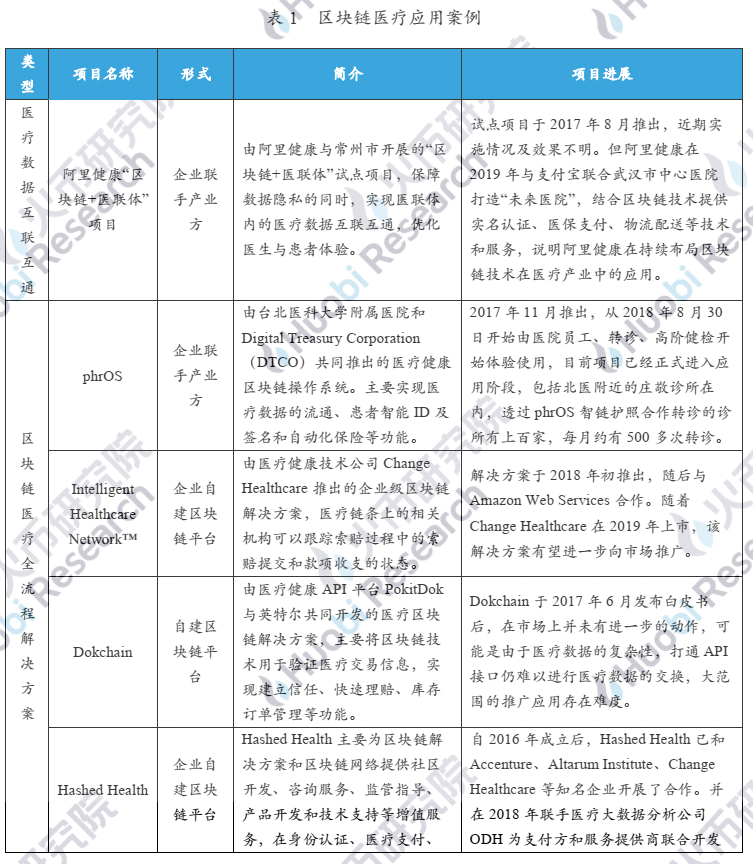

In general, blockchain technology is currently in the early stages of development, and it is difficult to process medical data with complex dimensions. Therefore, its application in the field of healthcare is not yet mature, and only some companies or organizations have tried it on a small scale. As the development of the blockchain technology matures and the medical and health industry further understands the blockchain, the blockchain can be widely used in the medical and health field. The following will briefly introduce and analyze each type of application case.
5.1 Medical Data Interconnection
Ali Health's " Medical Alliance + Blockchain " Project:
On August 17, 2017, Alibaba Health announced the cooperation with Changzhou to launch a pilot project of "Medical Federation + Blockchain", applying blockchain technology to the underlying technical architecture system of Changzhou Medical Federation, which is expected to solve long-term problems. "Islands of Information" and Data Privacy Security Issues in Medical Institutions.
The plan has been implemented in Changzhou Wujin Hospital and Zhenglu Town Health Center, and it will be gradually advanced to all third-level hospitals and grass-roots hospitals in Tianning District of Changzhou, and a comprehensive medical information network will be deployed.
Alibaba Health set up multiple data security barriers in the blockchain project. First, the data in the blockchain is encrypted. Even if the data is leaked or stolen, it cannot be decrypted. Secondly, the access and operation authority of Changzhou Medical Federation's lower and upper hospitals and government management departments were also agreed. Finally, the audit unit can use the blockchain's tamper-resistant and traceable technical characteristics to fully understand the circulation of medically sensitive data.
With the introduction of Ali Health's blockchain technology, medical data can be interconnected within the medical union, optimizing the experience of doctors and patients, and ensuring the implementation of hierarchical diagnosis and two-way referrals. Through the blockchain network, community residents can own the ownership of health data, and through authorization, the data can be transferred between the community and the hospital. Doctors at all levels in the medical union can obtain patient medical information under authorization. Know the patient's past medical history and related information. Patients do not need to perform repetitive examinations, reducing the money and time spent on this.

Blockchain technology realizes the information interconnection between hospitals, which is in line with the government 's guideline of “ let data walk more and people only go once ” , but the application of such technology will reduce the number of patient examinations and correspondingly reduce hospital revenue. As well as reducing personnel costs, the interests of relevant parties may be violated. Therefore, the application of such technology requires the government to take the lead in piloting it and implement it from top to bottom. It also needs to introduce new business models to encourage other hospitals to join the ecosystem so that the entire ecosystem can operate healthily and sustainably.
5.2 Blockchain Medical Full Process Solution
Medical health blockchain operating system phrOS:
Taipei Medical University Affiliated Hospital and Digital Treasury Corporation (DTCO) jointly released the medical and health blockchain operating system phrOS in November 2017. phrOS is the world's first hospital-wide blockchain integration project, fully opening up the sharing and exchange of health data, while ensuring data privacy, thereby accelerating cooperation in the healthcare industry.
The data on the system includes images and various information about the condition of the patient. Doctors and patients themselves can access this information through mobile device software. It also enhances the security of medical information through decentralized ledger technology (DLT).
The main applications of phrOS are as follows:
(1) Patient Intelligent ID
1. Anonymous digital identity for patient resume to achieve patient identification and identity management
2. Support patient data writing and query, including nursing and drug management in hospital
3. Track patient's health record
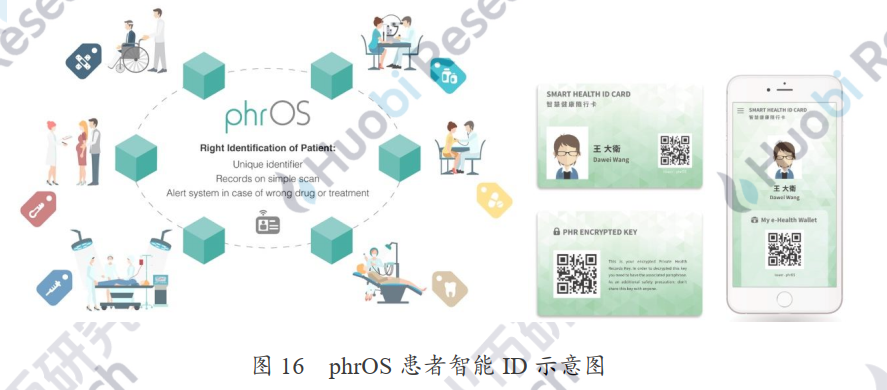
(2) Intelligent medical chain
It promotes the sharing of medical data between medical institutions and patients, improves the exchange of medical data information, the efficiency of patient medical record data security and privacy protection.
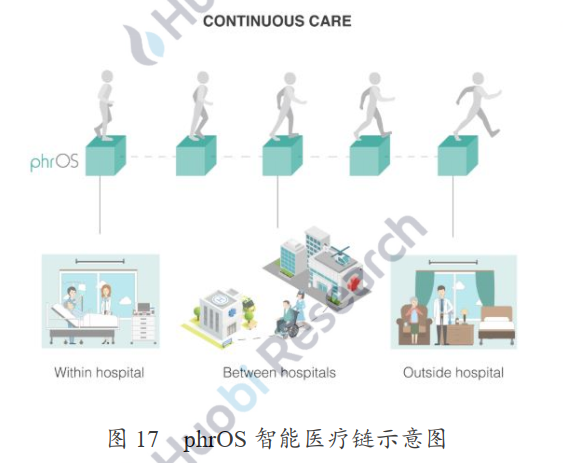
(3) Smart contract electronic signature
Smart contracts can be applied to clinical trials, simplify the management of patient electronic files, and improve the efficiency of the patient recruitment process in clinical trials.
(4) Automation insurance
It involves the authorization of medical data sharing between patients, hospitals and insurance companies. The data includes time stamps and medical records. All authorized data files have digital signatures, which can resolve any disputes without third-party services and review them anytime, anywhere.
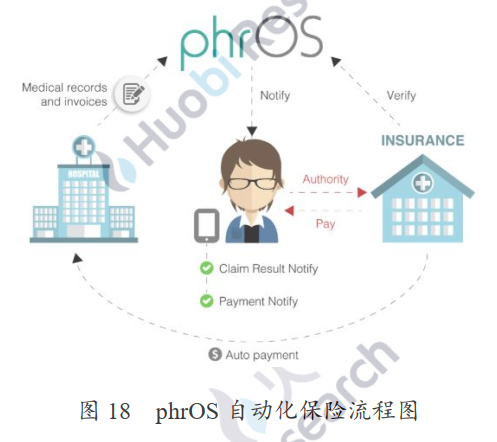
(5) Medical health data market
Connect data trading platforms for patients, doctors, and pharmaceutical companies to accelerate the development of new drugs. Researchers can obtain medical data directly from patients for academic research, and data analysis companies can obtain data for their reports and research.

Healthcare Healthcare Enterprise-Class Blockchain Solution Intelligent Healthcare Network ™
Change Healthcare is a healthcare technology company that provides software, analytics, network solutions, and technical support services to help create stronger, more collaborative healthcare collaboration systems.
ChangeHealthcare launched the Intelligent Healthcare Network ™, the first enterprise-level blockchain solution for healthcare in January 2018. Using blockchain technology, relevant institutions on the medical chain can track the status of claim submission and payment receipts and payments during the entire claim process, which improves the transparency, auditability, traceability and credibility of the entire claim chain. Good management of income cycle. The blockchain makes the entire process patient-centric, simpler and flatter, and stimulates more innovative products and cooperation.
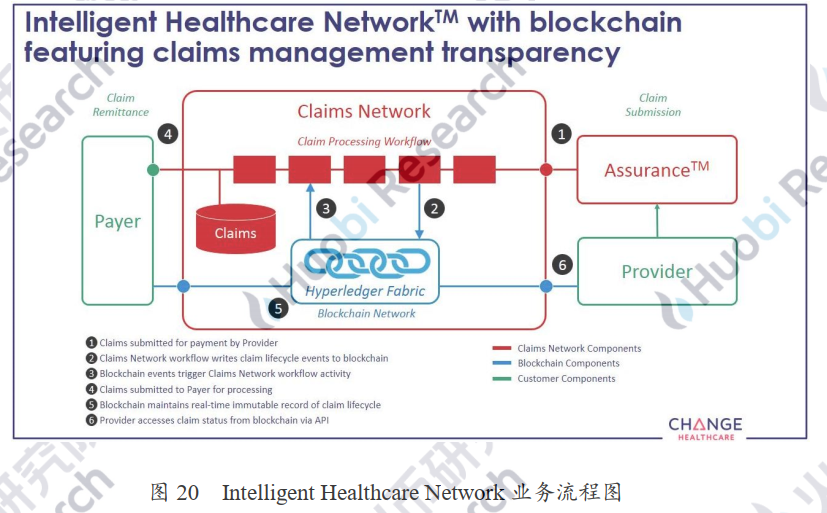
Intelligent Healthcare Network ™ is used to process clinical and payment data among various stakeholders in the healthcare industry, such as hospitals, doctors, companies, governments and other providers.
Through the blockchain network, the Intelligent Healthcare Network ™ currently processes more than 50 million claims per day, up to 550 transactions per second, and more than $ 2 trillion in claims each year. With the further optimization and expansion of the solution and technology framework, the platform performance is expected to improve significantly.
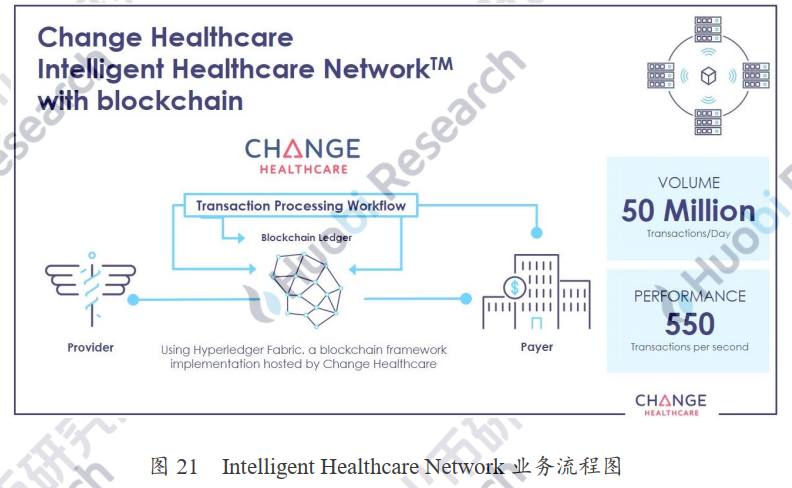
Medical blockchain technology solution Dokchain:
Medical API platform PokitDok and technology giant Intel reached a cooperation to jointly develop the medical blockchain solution "Dokchain". Intel will provide PokitDok with its open source software Hyperledger Sawtooth as the underlying distributed ledger for Dokchain, and use Intel chips for blockchain data processing. PokitDok's partners include not only Intel, but also more than 40 companies including Amazon, Capital One, Guardian and Ascension.
PokitDok provides an API interface for developers, allowing users to search the PokitDok supplier directory to enable businesses to implement basic services such as online stores, reservations, payments, and insurance. At the same time, PokitDok also provides App interfaces for third-party developers such as payment companies, public health systems, and medical and health companies. Developers can conveniently use the platform including payment processing, insurance company qualification review, referral, insurance compensation, and patient identity. Software framework for management and vendor search functions.
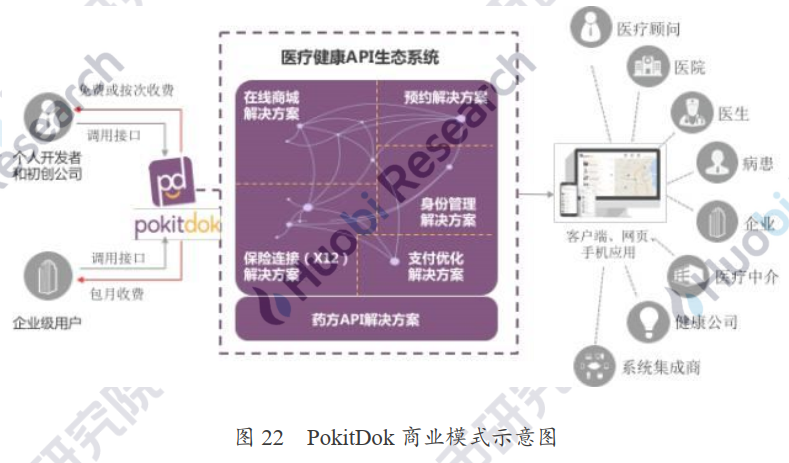
Dokchain's medical blockchain solution can provide identity management to verify multi-party information of medical transactions. After the information is verified successfully, the transaction will be automatically executed according to the established contract. Applying it to medical claims will greatly improve the efficiency of claims. In addition, Dokchain can also be used for the verification of the medical supply chain. For example, doctors' prescription information will be recorded on the blockchain, and the price of drugs will be more open and transparent. This will also have a profound effect on the inventory of medical supplies and order management influences. The application of Dokchain will effectively alleviate the current situation of information asymmetry in the medical industry, improve the trust problem of each node, avoid medical fraud, and effectively protect the privacy of patients.
Medical blockchain innovation company Hashed Health:
Hashed Health was founded in 2016 and is headquartered in Nashville, the capital of the State of Tennessee.It is a medical innovation company focusing on blockchain technology. Value-added services such as guidance, product development, and technical support to accelerate the design, development, and application of blockchain technology and networks.
Hashed Health has applications in multiple medical segments such as identity authentication, medical payments, health management, value medicine, clinical applications and supply chain management. Work with clients in the public and private sectors to develop distributed and decentralized solutions to solve medical service challenges.
(1) Identity authentication
Hashed Health has partnered with Illinois in the United States to build an interstate medical license platform that allows organizations such as medical institutions and health plans to verify the identity and qualifications of medical staff by combining the distributed trust layer of the blockchain.
(2) Medical payment
Hashed Health is trying to design a new medical payment ecosystem to help consumers make the most rational choices in healthcare.
(3) Health management
By building a blockchain-based health management platform, users can monitor their own health through wearable devices or other monitoring devices, and store personal health data on the chain for storage. Combining smart contracts can provide users with timely feedback on their health status. For example, in the event of an emergency, the platform will automatically send appropriate information to medical staff and their families as soon as possible to grasp the golden time of rescue and ensure the safety of users' lives. At the same time, the smart contract can also use health prevention resources to create a locally accessible healthy community project.
Hashed Health's health management platform will bring many benefits to users. Use smart health devices to track users' health status to develop personalized preventive medical care plans; manage care plans for acute and chronic diseases; timely monitor and manage the health status of the elderly , Handle emergency matters, improve emergency care and so on.
(4) Value Medical
The Hashed Health team goes back to the earliest ACE demonstration sites in the value medical model. The current value healthcare model is limited by trust, transparency and incentives. Hashed
Health's blockchain solution will be used in value payment, contract signing and revenue design.
(5) Clinical trials
Hashed Health is currently working with multiple pharmaceutical companies and government consultants to explore "decentralized IRB (institutional review board)" management, using blockchain technology to help IRB review and manage the results of multiple trial sites and multiple trial patients, reducing High test costs due to decentralized data.
(6) Supply chain management
Hashed Health's supply chain use cases include tracking and tracing, contract signing, master data management, and equipment lifecycle planning.
The above medical full-process solution aims to achieve data circulation in multiple scenarios such as medical consultation, digital payment, health management, clinical research, medical insurance, and supply chain management through blockchain technology, while ensuring data privacy, and completing each application node The organic interaction of data and the closed loop of the process improve the efficiency of the industry and optimize the user experience.
However, in the actual landing application, due to the large number of business links and business entities involved in the solution, it may face the problem of inconsistent data structures and formats of all parties. There are difficulties in the application promotion process, which can only be performed with limited partners. Small-scale attempts. In addition, a well-designed incentive scheme is essential to expand the alliance ecosystem. The more members the alliance has, the richer the data, the more comprehensive the service, the more comprehensive the service, and the better the user experience.
5.3 Blockchain Insurance Application
Easy to raise its easy insurance -the world's first full industry chain blockchain insurance product:
In October 2018, Easily Prepared signed a blockchain technology cooperation agreement with China Re Property Insurance and Huatai Insurance, reached a deep product cooperation relationship, and released the first full industry chain blockchain insurance product-Hongfu esheng exclusive enjoyment. Version Million Medical provides an intelligent, transparent, and safe health protection system through an innovative business model of "technological innovation + health protection".
As the first health insurance product that applies blockchain technology to the entire insurance industry chain, Hongfu eHealth Premium Edition Medical Insurance This product opens up front-end channels, mid-end underwriting, claims, and back-end re-development through the blockchain. Insurance and other links to improve the transparency and efficiency of Internet insurance.
The cooperation of the above three companies has promoted the circulation of data between all links, and improved the flexibility of insurance companies and reinsurance companies to adjust the annual renewal rate and the ability to manage risks. The embedding of blockchain technology has improved the operating efficiency of direct insurance companies and reinsurance companies, and the cost of insurance products has therefore been significantly reduced, laying the foundation for insurance models and ecological innovation.
As the first company to easily apply blockchain technology to health insurance, the product launched by Easy Fund is a user-centric product. From the user's point of view, it grasps user data. Through clear user portraits, it understands user attributes and Product claims to develop exclusive and accurate health insurance for different customers.
As a leading domestic health protection company, the ease of planning in the blockchain field provides new ideas and development directions for the entire industry. Hongfu eHealth Premium Edition Medical Insurance uses blockchain technology to solve the problem of unsmooth information on the industrial chain, opens up front-end channels, mid-end underwriting and back-end reinsurance, restructures the insurance ecosystem, and provides insurance for the Internet Improve efficiency. The organic combination of blockchain and Internet insurance has changed the way of data communication and sharing. At the same time, relying on the open, transparent and immutable characteristics of blockchain, it has labeled the data with credibility.
Tencent Cloud blockchain joins hands with Love Life to create an insurance blockchain alliance:
In November 2017, Tencent Cloud and Caring Life announced that the two parties reached an in-depth strategic cooperation relationship to build a blockchain alliance for medical institutions, insurance companies, health information platforms and other organizations, and use the blockchain to drive the implementation of the "smart + insurance" scenario.
Through the blockchain technology, the data circulation of the organizations in the alliance is opened, and the digital certificate information is stored safely and efficiently. On the basis of ensuring the security of medical data, the real sense of medical, insurance and other information security interconnections are achieved. Users provide efficient and secure insurance protection products and medical health services.
"Blockchain + insurance" on the one hand opens up the information sharing and circulation of medical institutions, insurance companies, policyholders and supervision, which improves the efficiency of the claims process and improves the control of risks and costs. On the other hand, automatic underwriting and automatic claims settlement through smart contracts reduce management costs.
Blockchain combined with medical insurance achieves a qualitative leap in the efficiency of the claims process, while optimizing the policyholder experience, it also achieves the purpose of reducing costs and improving efficiency for insurance companies. In the future, more medical institutions, insurance companies, and regional platforms (regulators) will join the insurance medical industry ecological alliance built with blockchain technology, and realize the blockchain direct insurance compensation model in the form of alliance chains.
5.4 Traceability of Drug Circulation
Jingdong Zhizhen Chain Medicine Traceability Platform:
JD.com launches a blockchain-based Zhizhen Chain medicine traceability platform, which provides intelligent vaccine management software and hardware solutions through this platform to ensure the transparent flow of information from the entire process of vaccine production, circulation to use. The data is recorded and its source is traced to ensure the quality and safety of the vaccine, make the terminal vaccination safer, and protect the medical safety of consumers.
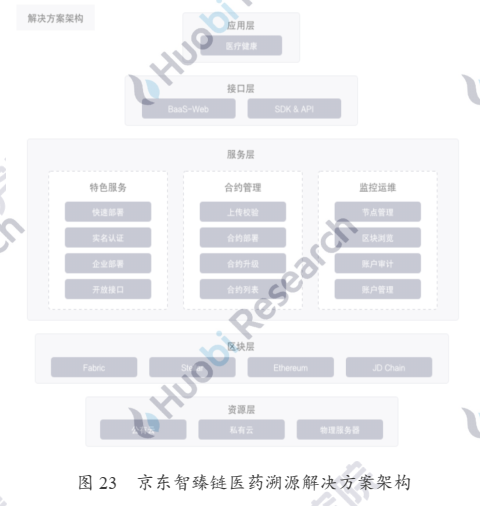
In terms of specific product application scenarios, JD.com and Hisense Biomedical Cold Chain reached a cooperation to jointly launch a blockchain vaccine traceability solution product and apply it to vaccination sites at all levels of cities. The blockchain technology can solve the disadvantages caused by the manual recording of vaccine data, such as easy tampering and data lag, so as to ensure the authenticity and safety of vaccine monitoring and solve the problem of difficult vaccine traceability.
In the traditional vaccine circulation process, there are many pain points such as many circulation links, opaque information, low terminal inventory management efficiency, and time-consuming labor statistics. Through the blockchain technology, JD.COM has opened up the information circulation of vaccines from production centers, cold chain logistics, disease centers, inoculation stations and other links, and can complete the final vaccination situation and even respond to information feedback. In addition, smart refrigerators are applied to terminal inoculation stations, providing management functions such as vaccine entry and exit, temperature control early warning, automatic inventory, out-of-stock warning, and retrospective scanning. Through the digitization of vaccine information combined with blockchain technology, it provides consumers with safe and secure services, greatly reducing the labor costs of vaccination stations and improving their work efficiency.

Through this smart vaccine traceability management system, consumers can learn the true circulation information of the vaccination through their mobile phones when they are vaccinated, and can receive the feedback of the results of vaccination in time, which is more reliable.
In addition to the cooperation with Hisense Medical Cold Chain, JD.com's anti-counterfeiting traceability platform in the medical field is gradually expanding its influence. In early 2019, it reached in-depth cooperation with Yinchuan Internet Hospital to implement a regional blockchain vaccine traceability solution. Up to now, the program has helped the inoculation stations achieve intelligent management of a total of 14 second-class vaccines and a total of 1,089 vaccinations, escorting 827 safe vaccination for 517 residents, and the correct vaccination rate is 100%.
Blockchain drug traceability platform MediLedger:
In September 2017, pharmaceutical companies such as Genentech and Pfizer jointly launched the MediLedger blockchain drug tracking project and conducted pilot applications.
The MediLedger platform complies with the relevant requirements of the Drug Supply Chain Security Act (DSCSA). Beginning November 27, 2019, the U.S. pharmaceutical industry will need to comply with new provisions of the Drug Supply Chain Security Act. One of the key points of the regulation is that all prescription drugs returned to distributors must be confirmed with the manufacturer for the uniqueness of the prescription drug product before resale.
The MediLedger project meets the requirements of DSCSA through the blockchain network. Nodes in the drug supply chain such as pharmaceutical manufacturers, wholesalers, and hospitals can record drug delivery data on the blockchain. Pharmacies and hospitals can benefit from automatic and timely real-time responses without the need to manually process phone and email-related During the process, the pharmacy can also securely request and respond to the verification request of the drug. At each step of the drug delivery process, the blockchain network can prove the origin and authenticity of the drug, making it extremely difficult for drug theft and trade-in. At the same time, only authorized companies can include products in the product catalog.
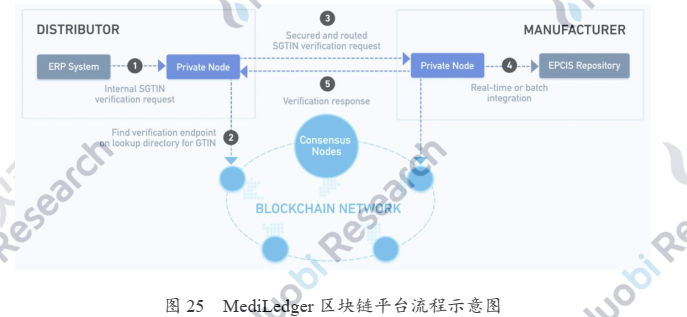
At present, the blockchain has been applied in multiple scenarios in the field of traceability. In the medical field, the blockchain can monitor the drug transfer process for all parties and prevent false drug sources. At the same time, for a special commodity such as a vaccine that is easily depleted and deteriorated, the blockchain can monitor the multi-dimensional data of vaccine storage time, temperature, and humidity in combination with IoT devices to ensure the quality and timeliness of vaccine drugs.
In the future, in addition to the drug supply chain traceability solution for enterprises, consumers also have great trust issues when purchasing drugs online. It is expected that a large number of pharmaceutical e-commerce companies will explore the application of blockchain technology in drug traceability, increasing consumer demand for drugs. The trust of the platform and products is safe and secure, and the people are assured.
5.5 Drug clinical development
Blockchain clinical trial solution provider Florence:
Founded in 2014, Florence serves clinical trial facilities and eliminates site-based clinical trial operation delays by developing software.
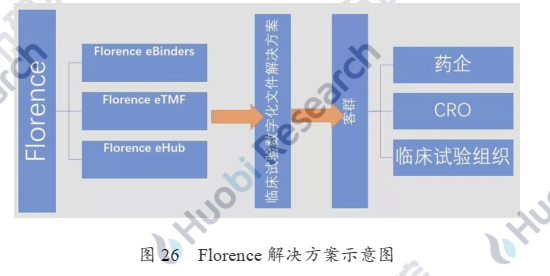
Florence's main products include Florence eBinders, Florence Etmf, Florence
eHub. Florence eBinders simplifies the workflow of clinical trial sites and improves work efficiency through leading digital management solutions.
Clinical research institutes using eBinders products said that the average research startup time of the institution was 20% faster, and the time period of the document was reduced by 40%. Researchers can complete more research content in the same time, and have higher quality and efficiency. . Currently, Florence's system covers more than 600 major disease areas in clinical trials.
And Florence eHub has built a bridge between clinical research institutions and pharmaceutical companies, saving research startup time, reducing the cost of communication between the two, accelerating the process of new drugs from research and development, clinical to final market, for more patients Escort your health.
The average research and development time of new drugs is more than 10 years, and the investment in research and development is amazing. The greatest value of Florence's products lies in reducing the research and development cycle and improving the efficiency of the research and development process.
Florence announced a partnership with Verady, a blockchain asset guarantee company, in 2017 to develop medical blockchain applications to advance medical and clinical research. Verady's API interface will provide an easy-to-use, standardized representational.
State Transfer (ReST) interface to abstract the complexity of the blockchain for Florence customers. The partner will work with several pharmaceutical companies to develop an open source blockchain application to manage patient and clinical trial data.
Encrypt patient data on the blockchain through blockchain technology, while protecting the privacy of patient data, and promoting the transfer of clinical data between institutions, enabling the lengthy process of drug development caused by lack of clinical data in the past. Shorten and improve the efficiency of drug development. With the circulation and sharing of clinical data, we can expect that in the future, the introduction of new drugs to cure various incurable diseases will become more frequent, because the number of clinical research data samples will increase, the drug development process will be more scientific, and the cure of new drugs The effect will be more obvious.
references:
1.Wang Jing.Analysis of Causes of High Drug Prices and Solutions [J] .Journal of Health Economics, 2005,10: 19-20.
2. Lei Feng Network reports: http://www.sohu.com/a/165688911_114877
3.phrOS official website: https://phros.io/#home
4.Change Healthcare official website: https://www.changehealthcare.com/
5. Beiqing Net reports: http://finance.ynet.com/2019/11/04/2180545t632.html
6. Hexun Report: http://insurance.hexun.com/2017-11-09/191568530.html
7. Jingdong Mathematics 100: http://baijiahao.baidu.com/s?id=1650258133414475234&wfr=spider&for=pc
8. Jingdong Zhizhen Chain official website: https://blockchain.jd.com/
9.36: Report: https://36kr.com/p/5074535
10.MediLedger official website: https://www.mediledger.com/
11. Sohu report: http://www.sohu.com/a/222501716_133140
12. Sohu report: http://www.sohu.com/a/249729480_133140
About the Author:
Mr. Yuming Yuan is the CEO of Huobi China and the president of the Huobi Research Institute.
Mr. Chen Shenghua is a researcher at Huobi Research Institute.
Mr. Mao Hua is a partner and managing director of Frost & Sullivan, and head of medical business in Frost & Sullivan Greater China.
Mr. Zhu Yi is the consulting director of Frost & Sullivan.
About Sullivan:
Global growth consulting firm, Sullivan, helps clients accelerate the pace of corporate growth and achieve industry-leading growth, innovation, and leadership. Sullivan provides services including strategy consulting, management consulting, planning consulting, industry consulting, financial consulting and other services.
We will continue to update Blocking; if you have any questions or suggestions, please contact us!
Was this article helpful?
93 out of 132 found this helpful
Related articles
- Analysis of Blockchain Concept Stocks | How Long Can Anni Shares Acquire Hot Spots?
- What laws could be violated by launching a 51% attack?
- Russian cabinet resigns collectively, domestic bitcoin premium $ 200
- DeFi's Dilemma and Change
- New acquisition + new business, founding member of Libra is accelerating expansion
- More than 70% of the 58 blockchain companies are happy to report that 13 of them are expected to double their net profit
- Observation | To what extent has the blockchain traced its origins?





